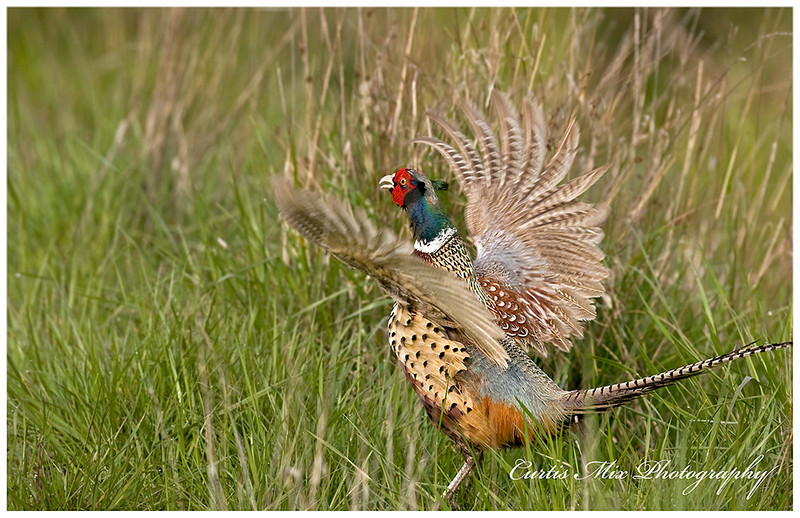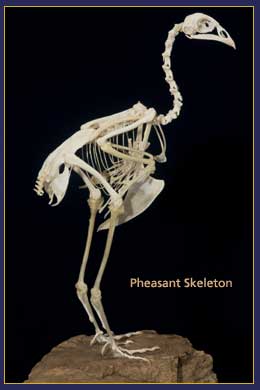Adaptation
Phasianus colchicus, better known
as the ring-necked pheasant, are dependent on two major habitats;
agricultural landscapes and grasslands. The ring-necked pheasant has
adapted in many
 ways in order to strive in these environments.
Physical adaptations in the pheasants include their size and color. The average male pheasant (cock) weighs 2 ½ to 3 ½ pounds (female 2
to 3 pounds) which allows it to dissuade predators and capture small
prey to consume. Additionally, with their brown and white feather
coat, the marshes and low lying grasses provide excellent cover for
the females and young offspring. However, the male pheasants look
surprisingly different. As described by Chris Dorsey in his book,
“Pheasant Days”, the cock looks like a chicken would if you were to
dip the bird in a box of melted crayons (Dorsey, 1992). The cock has bright
blue-green feathers with red patches on its face which ends with a
white ring around its neck, hence, the ring-necked pheasant. The
pheasant cock struts his colors proudly for all to see but most
importantly to attract the female pheasants.
ways in order to strive in these environments.
Physical adaptations in the pheasants include their size and color. The average male pheasant (cock) weighs 2 ½ to 3 ½ pounds (female 2
to 3 pounds) which allows it to dissuade predators and capture small
prey to consume. Additionally, with their brown and white feather
coat, the marshes and low lying grasses provide excellent cover for
the females and young offspring. However, the male pheasants look
surprisingly different. As described by Chris Dorsey in his book,
“Pheasant Days”, the cock looks like a chicken would if you were to
dip the bird in a box of melted crayons (Dorsey, 1992). The cock has bright
blue-green feathers with red patches on its face which ends with a
white ring around its neck, hence, the ring-necked pheasant. The
pheasant cock struts his colors proudly for all to see but most
importantly to attract the female pheasants.
During the late fall and winter months, most
ring-necked pheasants do not migrate south for warmer weather,
instead, the females gather in large groups while the males
congregate in small groups or live alone. As social birds, each
flock stays together to find food, seek shelter from the weather,
and keep many eyes out for danger. Together, the birds seek shrubby,
dense areas or sometimes even trees to roost in. Thick cover is
essential for the survival of the pheasant. Many pheasant
populations have declined rapidly in response to habitat loss from
urbanization and changed agricultural products (Smith et al. 1997)
as well as vegetation removal by farmers (Frey et al. 2003).
Pheasants use the sides of agricultural fields to raise young, seek
shelter, and avoid predation; without that cover, the pheasants
cannot survive.
 Movement adaptations are most likely the most important
adaptation for the ring-necked pheasant. Pheasants use their ability
to move to avoid predation, seek shelter, and scrounge the ground
for food. The ring-necked pheasant spends most of its time on the
ground, scratching for food with its feet or beak. However, the
pheasant is an extremely, strong flier; when startled, the pheasant
takes off from its cover at almost a vertical shot. This flush (take
off flight) makes hunting this game bird a frightful delight. For
the pheasant, however, it makes a swift attempt of escaping the
predator. This spectacular flush is only possible with the specially
designed wings the pheasant possess. The ring-necked pheasant has
short, fat wings which allow them to use a lot of upward thrust to
pull themselves off the ground quickly. In addition, the specialized
wings also aid in steering the pheasant efficiently around
obstacles. However, the pheasant wings are not meant for long
distance flight but only for fleeing from predators (Project BEAK
2013). Another way the pheasant avoids predation is with its
exceptionally fast running speed on the ground. Each escape pattern
guides the bird with intentions to finding the safest, most dense
area in which they can hide from predators.
Movement adaptations are most likely the most important
adaptation for the ring-necked pheasant. Pheasants use their ability
to move to avoid predation, seek shelter, and scrounge the ground
for food. The ring-necked pheasant spends most of its time on the
ground, scratching for food with its feet or beak. However, the
pheasant is an extremely, strong flier; when startled, the pheasant
takes off from its cover at almost a vertical shot. This flush (take
off flight) makes hunting this game bird a frightful delight. For
the pheasant, however, it makes a swift attempt of escaping the
predator. This spectacular flush is only possible with the specially
designed wings the pheasant possess. The ring-necked pheasant has
short, fat wings which allow them to use a lot of upward thrust to
pull themselves off the ground quickly. In addition, the specialized
wings also aid in steering the pheasant efficiently around
obstacles. However, the pheasant wings are not meant for long
distance flight but only for fleeing from predators (Project BEAK
2013). Another way the pheasant avoids predation is with its
exceptionally fast running speed on the ground. Each escape pattern
guides the bird with intentions to finding the safest, most dense
area in which they can hide from predators.
Lastly, the ring-necked pheasant has adapted competition
strategies within their own species. As with any species,
reproductive success is mandatory in order to keep beneficial
traits, therefore, pheasant males (cocks) compete
with each other in
order to win over a certain territory where females are present. To
establish a breeding territory, cocks
compete by flying at each other, wing-flapping, biting and kicking
at each other (Animal Diversity Web, 2013). The winner of the fight then defends
and reproduces with females within the won territory.
Everyone likes babies! Click reproduction to see the newly hatched chicks!
